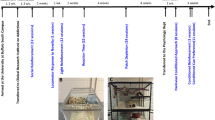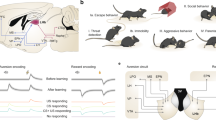Abstract
HUGHLINGS-JACKSON1 has expressed the view that, during ontogenesis, neural centres responsible for inhibition develop more slowly than centres responsible for excitation. Since then, the working hypothesis has been that the later-developing, phylogenetically ‘higher’ neural centres act to regulate (inhibit?) the excitation of the ‘lower’ centres. There has been some behavioural and physiological support for this position. In altricial mammalian species the hippocampus and neocortex become functionally mature relatively late in development2, and the hippocampus, in particular, has been implicated in the expression of behavioural inhibition3–5. Preweanling rats, during weeks 3 and 4 of life, seem to lack maturity for tasks requiring suppression of responding; for example, they are deficient in passive avoidance6 learning and in habituating to novel stimuli7,8. Their performance in excitatory tasks, such as active avoidance9 and approach for food10, seems to be less deficient. These task-specific deficits resemble those shown in hippocampally lesioned adult animals11. Campbell et al. have noted the correspondence between later-developing inhibitory centres in the rat and the decline in spontaneous activity occurring during ontogenesis12, and have demonstrated that psychopharmacological agents13 and brain lesions14 specific to inhibitory systems are ineffective in increasing behavioural arousal early in development. In our laboratory, experiments on instrumental appetitive learning in preweanling rats have involved the use of dry food pellets as reinforcers in pups as young as 17 to 20 d of age. In animals as young as this, we have demonstrated acquisition, extinction, immediate persistence, and long term persistence using procedures that are similar to those for adult rats15–17. We now report two experiments demonstrating behavioural plasticity in the 10-d-old rat, involving acquisition and subsequent extinction of an approach response where reward is the opportunity to suck briefly from an anaesthetised mother rat.
This is a preview of subscription content, access via your institution
Access options
Subscribe to this journal
Receive 51 print issues and online access
$199.00 per year
only $3.90 per issue
Buy this article
- Purchase on Springer Link
- Instant access to full article PDF
Prices may be subject to local taxes which are calculated during checkout
Similar content being viewed by others
References
Hughlings-Jackson, J., Brain, 9, 1–23 (1886).
Altman, J., and Das, G. D., J. comp. Neurol., 124, 319–336 (1965).
Altman, J., Brunner, R. L., and Bayer, S. A., Behav. Biol., 8, 557–596 (1973).
Douglas, R. J., Psych. Bull., 67, 416–442 (1967).
Kimble, D. P., Psych. Bull., 70, 285–295 (1968).
Riccio, D. C., Rohrbaugh, M., and Hodges, L. A., Devl Psychobiol., 1, 108–111 (1968).
Feigley, D. A., Parsons, P. A., Hamilton, L. W., and Spear, N. E., J. comp. Physiol. Psych., 79, 443–452 (1972).
Bronstein, P. M., Neiman, H., Wolkoff, F. D., and Levine, M. J., Anim. Learn. Behav., 2, 92–96 (1974).
Kirby, R. H., J. comp. Physiol. Psych., 56, 158–162 (1963).
Campbell, B. A., Jaynes, J. R., and Misanin, J., J. comp. Physiol. Psych., 66, 467 (1968).
McCleary, R. A., in Progress in Physiological Psychology (edit. by Stellar, E., and Sprague, J. M.) (Academic, New York, 1966).
Campbell, B. A., Lytle, L. D., and Fibiger, H. C., Science, 166, 637–638 (1969).
Mabry, P. D., and Campbell, B. A., J. comp. Physiol. Psych., 86, 193–201 (1974).
Moorcroft, W. H., Brain Res., 35, 513–522 (1971).
Chen, J. S., and Amsel, A., J. comp. Physiol. Psych., 89, 238–245 (1975).
Burdette, D. R., Brake, S. C., Chen, J. S., and Amsel, A., Anim. Learn. Behav., 4, 131–138 (1976).
Amsel, A., and Chen, J. S., J. comp. Physiol. Psych. (in the press).
Lincoln, D. W., Hill, A., and Wakerley, J. B., J. Endocr., 57, 459–476 (1973).
Schapiro, S., and Salas, M., Physiol. Behav., 5, 815–817 (1970).
Gregory, E. H., and Pfaff, D. W., Physiol. Behav., 6, 573–576 (1971).
Leon, M., and Moltz, H., Physiol. Behav., 8, 683–686 (1972).
Amsel, A., in Inhibition and Learning (edit. by Boakes, R. A., and Halliday, M. S.) (Academic, London, 1972).
Author information
Authors and Affiliations
Rights and permissions
About this article
Cite this article
AMSEL, A., BURDETTE, D. & LETZ, R. Appetitive learning, patterned alternation, and extinction in 10-d-old rats with non-lactating suckling as reward. Nature 262, 816–818 (1976). https://doi.org/10.1038/262816b0
Received:
Accepted:
Published:
Issue Date:
DOI: https://doi.org/10.1038/262816b0
This article is cited by
-
Effects of antimuscarinic cholinergic drugs injected systemically or into the hippocampo-entorhinal area upon passive avoidance learning in young rats
Psychopharmacology (1982)
-
Experimental methods in behavioral teratology
Archiv f�r Toxikologie (1981)
Comments
By submitting a comment you agree to abide by our Terms and Community Guidelines. If you find something abusive or that does not comply with our terms or guidelines please flag it as inappropriate.



